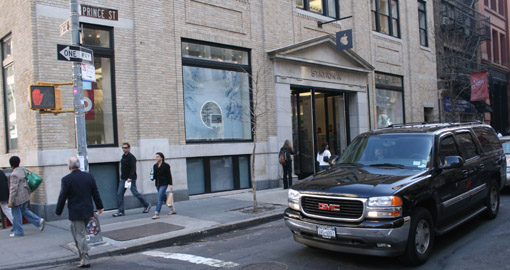Rethinking Soho

A Porsche, an ambulette, Paul Steely White, Bruce Schaller and a vendor compete for street space in Soho
Crowded shoppers and residents want more sidewalk space in Soho and they would be happy to give up some of the area’s parking space to get it, according to a study released today by Transportation Alternatives (Download a PDF version here). Conducted by seemingly omnipresent transportation consultant Bruce Schaller, who issued a mammoth report on New York City traffic congestion for the Manhattan Institute last week, the study’s results were based on interviews with 1,000 drivers and pedestrians along Prince Street.
"People perceive Soho’s streets to be very crowded," Schaller said at a press conference held this morning in a prime parking spot that he was lucky enough to find right across the street from the Apple store on Prince and Green. "The sidewalk widths and design of these streets hasn’t changed since this was a manufacturing area decades ago." Schaller’s study makes the case that giving more street space to pedestrians would be "a win-win-win for Soho’s visitors, residents and business owners."
The study found that:
- 89% of the people who use Prince Street are arriving by subway, bus, walking or bicycle. Only 9% arrive by car.
- By a ratio of 5:1 shoppers said they would come to Prince Street more often if they had more space to walk, even if it meant eliminating parking spaces. Interestingly, this ratio was nearly identical for visitors and those who live and work in the area.
- Most shoppers would rather see space taken away from parked cars rather than street vendors.
- And this surprising, interesting result: The shoppers who value wider sidewalks over parking spent about five times as much money, in aggregate, as those who value parking over sidewalks. Or, as White puts it, "The people who are willing to forgo parking for sidewalks are the big spenders."
Schaller’s report concludes, "The major implication of the study is that Prince Street would be improved for visitors, residents and workers through an expansion of the space allocated to pedestrians."
 White says T.A. has no specific street design or street closing recommendations at this time. "That has to come out of a consensus-building process with community stakeholders." Nevertheless, he offered a few ideas of what might emerge from such a process: "You might consider eliminating parking on one side of the street and super-sizing one of the sidewalks or making Prince Street between Broadway and Sixth Avenue a pedestrians-only zone on a Saturday, perhaps even during next year’s holiday season," he said. A similar pedestrianization project was just done on a pair of major shopping streets in London two weeks ago, with reports of great results.
White says T.A. has no specific street design or street closing recommendations at this time. "That has to come out of a consensus-building process with community stakeholders." Nevertheless, he offered a few ideas of what might emerge from such a process: "You might consider eliminating parking on one side of the street and super-sizing one of the sidewalks or making Prince Street between Broadway and Sixth Avenue a pedestrians-only zone on a Saturday, perhaps even during next year’s holiday season," he said. A similar pedestrianization project was just done on a pair of major shopping streets in London two weeks ago, with reports of great results.
Charles Hughes, a street vendor whose table of books and screenplays stood adjacent to the morning press conference, wasn’t buying any of it. "This is just an indirect way to get rid of street vendors and make the place look like Beverley Hills," he said. "They just want to make New York City even more bland."
Related Links:
- Photo simulation: Re-envisioning West Broadway.
- Streetfilms Grand Street: Looking at the absurdity of how narrow Soho sidewalks are and how they could be easily widened.
- Streetfilms Psychic Space: TOPP founder Mark Gorton points out the difference in how cars and traffic congestion change the way streets feel.
- Streetfilms Broadway & Houston: On weekends Soho is crammed with shoppers and pedestrians. Still the city is chipping away at sidewalk space.
- Photo simulation: Re-envisioning Grand Street.






